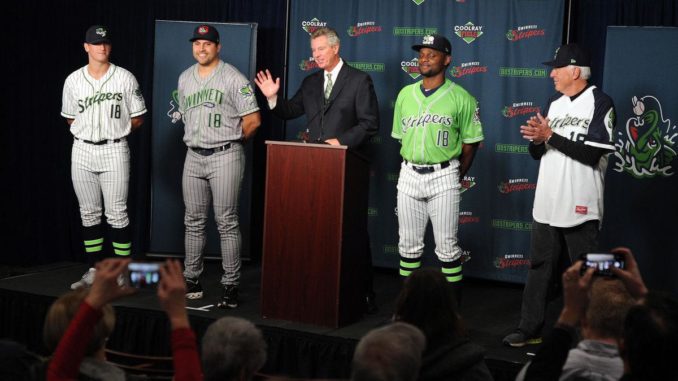
This season brought a new name and new uniforms to the AAA team formerly known as the Gwinnett Braves, but the missions were the same: be ready to provide depth to the major league team at the drop of a hat and serve as the Masters-level course for prospects close to the majors. In this, manager Damon Berryhill and his staff did a superb job, with 11 Opening Day Stripers eventually spending some time with Atlanta, and handling 16 of OFR’s top 50 pre-season prospects at some point over the course of the year.
Other articles in this series:
Team Review 2018: Mississippi Braves
Team Review 2018: Florida Fire Frogs
Team Review 2018: Rome Braves
Team Review 2018: Danville Braves
Team Review 2018: Gulf Coast League Braves
Sunday Farm Report 8/26/2018: Dominican Summer League Braves
The Stripers ended the season with a 70-69 record, good for 2nd place in the International League South Division, Gwinnett’s first winnings season since the Brian Snitker-led 2015 team. This is a testament to the perseverance of the club which endured near-constant roster disruption, especially to the their starting rotation. Of the Opening Day rotation of Mike Soroka, Matt Wisler, Lucas Sims, Kolby Allard, and Aaron Blair, only Allard would continue to make regular starts with the team, with Wisler and Sims regularly recalled to Atlanta and Soroka called up on May 1 and not return.
Blair would only make one start for Gwinnett before succumbing to a season-ending shoulder injury. Starters who would fill in like Max Fried, Luiz Gohara, and Wes Parsons would also experience riding the Gwinnett-to-SunTrust Park shuttle. The team’s best run of the season occurred late when starters Bryse Wilson, Touki Toussaint, and Kyle Wright were promoted from AA Mississippi for the month of August and provided overall outstanding starting pitching before they too were promoted to Atlanta after the minor season concluded.
For all the turmoil in the starting rotation, the everyday position players were mostly stable after the month of May. Minor league veterans like Jaff Decker, Christian Colon, and Ezequiel Carrera were quickly jettisoned after slow starts, and a core group of Stripers centered around infielders Rio Ruiz, Sean Kazmar, and Carlos Franco, outfielders Dustin Peterson, Danny Santana, and Xavier Avery, and catcher Chris Stewart provided a backbone to the line-up that could be added or subtracted to with minimal disruption.
Two happy disruptions was the promotions of third baseman Austin Riley and outfielder Michael Reed. Riley arrived as one of the hottest hitters in the minor leagues and looked well on his way to establishing himself in AAA when he was sidelined for a month with a knee injury, leaving the team perhaps to wonder if they could have made a playoff run with more time with the Braves top position player prospect.
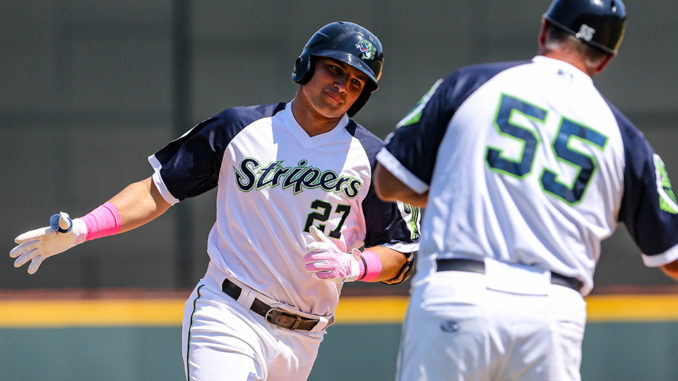
Infield
Long-time Braves farmhand Carlos Franco manned first base for most of the season. Relieved of third base duties, Franco put more weight on his substantial frame and as a result he led the International League in home runs and slugging percentage for much of the season. He faded in July and missed some time in August, but ended the season with 5 home runs in the final month. Going into his age 27 season and a minor league free agent, he may have to try another organization to have a better avenue to the majors. Rio Ruiz played 36 games at first, mostly after Austin Riley’s promotion when Franco was DHing or disabled.
Second base changed hands several times over the course of the season. Minor league free agent Christian Colon and minor league Rule V draftee Tyler Smith split time at the position for the first month, but Colon was quickly dropped from the roster after he batted .204/.278/.204 after the first weeks of the season with shaky defense. Smith and Gwinnett mainstay Sean Kazmar Jr. shared the spot until old friend Philip Gosselin was acquired on waivers in early May. Smith was let go in early July and Gosselin and Kazmar shared the position the rest of the way with veteran Ryan Flaherty getting some time at the position late in August and Danny Santana getting 14 games there as well to keep his utilityman credentials renewed. All of this said, the position was fairly unproductive, with Gosselin’s .251/.319/.384 the best offensive line of the bunch.
Shortstop was headed down the same road as second base until minor league free agent Luis Marte was promoted from Mississippi in mid-July. Until that point Kazmar and Smith were holding down the position with solid defense and poor production. Marte arrived continued his hot streak from Mississippi and hit .336/.356/.438 over his first 30 games. All good things must come to an end however, and Marte’s wild ride came to a half the last two weeks of the season as he hit .109/.140/.164.
Third base was handled primarily by prospect Austin Riley, who arrived from Mississippi in early May, moving Rio Ruiz off the position an into a floating LF/RF/1B/DH role until Riley strained his knee in early June, allowing Ruiz to resume his work at third. Riley missed a month of action, and when he returned, Ruiz went back to roving the corner spots of the diamond. Between Riley and Ruiz, third base was a productive position, with Riley hitting .282/.346/.464 with Gwinnett and Ruiz hitting .302/.338/.438 while manning the hot corner. Both provide above average defense, with Riley showing to be a plus defender before the knee made him lose a half-step.

Outfield
The most common outfield alignment this season was Dustin Peterson in left field, Danny Santana in centerfield, and Xavier Avery in right field. Of those three, the veteran Santana had the most productive season, hitting .264/.294/.497 and tying Carlos Franco for the team lead with 16 home runs and leading the team with 12 stolen bases. Santana is stretched in centerfield defensively.
Coming off a season in which he was trying to recover from a broken hamate bone in his hand, Dustin Peterson showed up in spring training with a revamped swing in an effort to boost his status with the club. While he hit some impressive dingers in camp, he found himself back in Gwinnett, where he hit .289/.347/.478 with 3 home runs before going on the DL with an injury in early May. He had just returned to action when Ronald Acuña injured his back and knee, and Peterson got The Call.
In one of the few times this season where there seemed to be a disconnect between the Braves front office and the Atlanta coaching staff, Peterson did not get a start, with manager Brian Snitker instead opted to platoon Charlie Culberson and Preston Tucker in left field. Peterson was returned to Gwinnett after three days and two at-bats, and would not get another opportunity with Atlanta. Instead he would slump through the month of June, and by the time his bat came back around, Acuna was healthy and Culberson had proven to be a reliable back-up. Overall Peterson hit a solid but unremarkable .268/.324/.406 and was waived after the season.
Avery also put up solid but unremarkable numbers in season where he seemed to be banged up quite a bit, hitting .261/.356/.365, and his home run total dropping to 4 from last year’s career high of 14 and his stolen base output dropping from 21 down to 9.
The most productive outfielder for Gwinnett was minor league free agent Michael Reed, who hit .363/.459/.539 with 7 homers and 4 stolen bases while leading the team in OPS. Unfortunately for the Stripers, Reed only appeared in a total of 53 games with the team; he started the season with Mississippi and played there the two months of the season. His tenure with Gwinnett was also interrupted by two stints with Atlanta. He would have been a strong candidate for a postseason bench spot, but a lower back strain in early September landed him on the Atlanta 60-day disabled list.
Early in the season, the outfield was blessed with the services of Ronald Acuna as the team manipulated his service time. Minor league free agent outfielders brought into the organization and in the offseason and not named “Michael Reed” didn’t fare particularly well, with Jaff Decker and Ezequiel Carrera released before the end of April.
Catching
For the majority of the season, the catching duties were handled by veterans Rob Brantly and Chris Stewart, solid defensive caretakers who brought little to the game offensively but knew how to coax good performances from the talented but constantly churning pitching staff.
Brantly was unceremoniously released in mid-July after the team promoted prospect Alex Jackson from Mississippi. While Jackson struggled at the plate all season, he continued to make strides behind it, and received strong marks for his game calling and pitch framing.
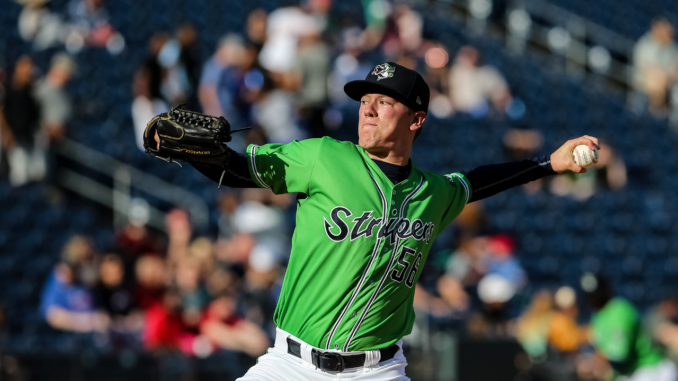
Starting Pitching
Twenty-five pitchers recorded at least one start for Gwinnett, reflecting the tumult that comes with supplying fresh arms for the major league squad. In some weeks, entire turns of the rotation seemed to be comprised of emergency starters.
The most starts for the team went to left-hander Kolby Allard, who had a solid first AAA campaign at the age of 21, making him one of the youngest players in the International League. Allard pitched to a 2.72 ERA in 19 starts, only missing two turns; once when he was recovering from an injury incurred while fielding a ball, and once when he was called up for a start in Atlanta. While Allard gives up a lot of contact, some of it hard, he managed to be successful by limiting walks and home runs.
Mike Soroka was the Opening Day starter and was brilliant in his one month with the club, pitching to a 2.00 ERA and striking out over 10 batters per nine innings. Soroka was promoted to Atlanta on May 1 and did not return to Gwinnett.
Wes Parsons appeared in 16 games for Gwinnett, starting in 14. Parsons had the most successful season of his career, pitching to a 3.38 ERA in time with both Gwinnett and Mississippi and most importantly staying healthy all season. He parlayed this success into three call-ups to Atlanta, although he only got into one game.
Lucas Sims and Matt Wisler started 14 and 13 games for Gwinnett respectively, with Sims pitching particularly well. Both former top prospects were packaged to Cincinnati at the trade deadline for outfielder Adam Duvall.
Max Fried and Luiz Gohara also pitched for Gwinnett in between call-ups to Atlanta, and both also had two re-hab stints with Gwinnett and their performance numbers reflect that they were battling through injuries.
The other significant starting pitchers came to the club late. Touki Toussaint, Kyle Wright, and Bryse Wilson all got August call-ups to Gwinnett. Toussaint and Wright experienced immediate success in the rotation, especially Toussaint who was dominating in his 8 starts with the club, paving the way for his late-season extended look as a starter for Atlanta. Wright had four good starts for Gwinnett before moving to the bullpen to get him acclimated to the role that Atlanta would use him for in September.
Wilson initially had two subpar starts out of the gate with the Stripers, but then pitched an 8-inning 1-hit shutout with 13 strikeouts that, by Game Score, was the single most dominating start thrown by a Braves starter in the minor leagues in 2018. This staged his major league debut the following week.
Relief Pitching
While the rotation was in a constant state of flux, with Atlanta using Gwinnett starters for both emergency starts and in relief stints, the bullpen squad remain relatively stable.
Right-handers Miguel Socolovich and Jason Hursh were the workhorses in the bullpen, with Socolovich being a particular steadying influence. The minor league free agent had 30 appearances, including 3 emergency starts, and pitched to a 2.65 ERA.
Also pitching in a lot of games but not providing much in the way of stability was veteran lefty Rex Brothers. Brothers was actually on Atlanta’s Opening Day roster, but he quickly found himself back in Gwinnett. He still has good stuff, as his 12+ strikeouts per nine inning ratio can attest to, but he had a walk rate that could make Mauricio Cabrera blush. After posting a 7.24 ERA in 32 innings, Brothers was relegated down to Mississippi.
Phil Pfeifer is another lefty that had major league aspirations in 2018 that fell short. Pfiefer had an 8.10 ERA after two months with Gwinnett before going down to Mississippi to get his mechanics straightened out. To his credit he put that time to good use and return to the Stripers before the end of the season and pitched well down the stretch.
Chad Bell is another left-hander that had a tough season. Acquired off the waiver wire early in the season, Bell pitched fairly well through most of the season — he had a 3.23 ERA for Gwinnett in mid-July — and even got a call-up to Atlanta at one point, but didn’t not get into a game. Bell faded badly down the stretch however and ended up with an unsightly 6.22 ERA.
Among the right-handers, the most remarkable season was turned in by Josh Ravin, who was acquired from the Dodgers in the off-season. In between two early call-ups to Atlanta, Ravin pitched in a total of 19 games for Gwinnett and did not allow an earned run. Unfortunately his season was cut short in mid-June by a comebacker that struck him in the head, leading to hospitalization and a lengthy recovery that cost him the rest of his season.
Gwinnett also got good work from righty Evan Phillips, who was the team’s de facto closer before eventually getting called up to Atlanta, then getting traded to Baltimore in the Kevin Gausman deal. After the trade, closing duties were shared between 24-year-olds Jacob Webb and Chad Sobotka, fellow 2014 draftees with strong arms and injury-filled histories. While both pitched well, it was Sobotka who caught the internal scouts eyes with his improved slider and who got the late-season call-up.
Finally, the bullpen was bolstered by two second-half call-ups by of two strong left-handers, Corbin Clouse and Adam McCreery. Both pitched well in late-season action for the Stripers and will be bullpen candidates for the Braves this spring.
TOP 10 2018 GWINNETT STRIPERS PROSPECTS:
- 3B Austin Riley
- RHP Touki Toussaint
- RHP Kyle Wright
- RHP Bryse Wilson
- C Alex Jackson
- LHP Corbin Clouse
- RHP Chad Sobotka
- OF Michael Reed
- RHP Jacob Webb
- LHP Adam McCreery

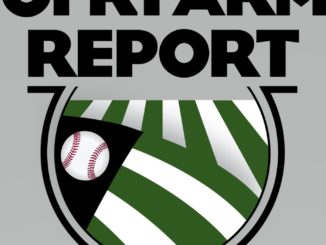
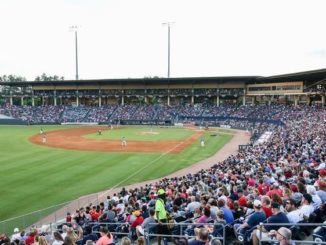
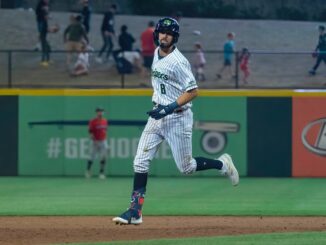
Leave a Reply